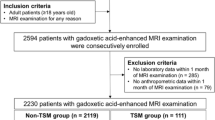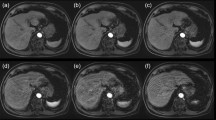Abstract
Objectives
To compare the occurrence of transient severe motion (TSM) between gadoxetate disodium- and gadopentetate dimeglumine-enhanced MRI and between gadoxetate disodium-enhanced MRI scans obtained with and without the application of a modified breath-holding technique.
Methods
We reviewed 80 patients who underwent two magnetic resonance examinations (gadoxetate disodium-enhanced MRI and gadopentetate dimeglumine-enhanced MRI) with the application of a modified breath-holding technique (dual group). This group was compared with 100 patients who underwent gadoxetate disodium-enhanced MRI without the application of the modified breath-holding technique (single group). Patient risk factors and motion scores (1 [none] to 5 [non-diagnostic]) for each dynamic-phase imaging were analysed.
Results
In the dual group, mean motion scores did not differ significantly between gadoxetate disodium- and gadopentetate dimeglumine-enhanced MRI (p=0.096–0.807) in any phase. However, in all phases except the late dynamic phase, mean motion scores of the dual group were significantly lower than those in the single group. TSM incidence did not differ significantly between gadoxetate disodium- and gadopentetate dimeglumine-enhanced MRI in the dual group (3.8% vs. 1.3%, p=0.620).
Conclusion
With proper application of the modified breath-holding technique, TSM occurrence with gadoxetate disodium-enhanced MRI was comparable to that associated with gadopentetate dimeglumine-enhanced MRI.
Key Points
• The modified breath-holding method significantly reduced the incidence of TSM.
• Gadoxetate disodium and gadopentetate dimeglumine showed comparable motion scores.
• TSM incidence was comparable between gadoxetate disodium- and gadopentetate dimeglumine-enhanced MRI.


Similar content being viewed by others
Abbreviations
- TSM:
-
Transient severe motion
- COPD:
-
Chronic obstructive pulmonary disease
- MELD:
-
Model for End-stage Liver Disease
References
Bashir MR, Gupta RT, Davenport MS, Allen BC, Jaffe TA, Ho LM et al (2013) Hepatocellular carcinoma in a North American population: does hepatobiliary MR imaging with Gd-EOB-DTPA improve sensitivity and confidence for diagnosis? J Magn Reson Imaging 37:398–406
Chung YE, Kim MJ, Kim YE, Park MS, Choi JY, Kim KW (2013) Characterization of incidental liver lesions: comparison of multidetector CT versus Gd-EOB-DTPA-enhanced MR imaging. PLoS One 8:e66141
Muhi A, Ichikawa T, Motosugi U, Sou H, Nakajima H, Sano K et al (2011) Diagnosis of colorectal hepatic metastases: comparison of contrast-enhanced CT, contrast-enhanced US, superparamagnetic iron oxide-enhanced MRI, and gadoxetic acid-enhanced MRI. J Magn Reson Imaging 34:326–335
Grazioli L, Bondioni MP, Haradome H, Motosugi U, Tinti R, Frittoli B et al (2012) Hepatocellular adenoma and focal nodular hyperplasia: value of gadoxetic acid-enhanced MR imaging in differential diagnosis. Radiology 262:520–529
Choi JY, Lee JM, Sirlin CB (2014) CT and MR imaging diagnosis and staging of hepatocellular carcinoma: part I. Development, growth, and spread: key pathologic and imaging aspects. Radiology 272:635–654
Choi JY, Lee JM, Sirlin CB (2014) CT and MR imaging diagnosis and staging of hepatocellular carcinoma: part II. Extracellular agents, hepatobiliary agents, and ancillary imaging features. Radiology 273:30–50
Frydrychowicz A, Nagle SK, D'Souza SL, Vigen KK, Reeder SB (2011) Optimized high-resolution contrast-enhanced hepatobiliary imaging at 3 tesla: a cross-over comparison of gadobenate dimeglumine and gadoxetic acid. J Magn Reson Imaging 34:585–594
Seale MK, Catalano OA, Saini S, Hahn PF, Sahani DV (2009) Hepatobiliary-specific MR contrast agents: role in imaging the liver and biliary tree. Radiographics 29:1725–1748
Schmid-Tannwald C, Herrmann K, Oto A, Panteleon A, Reiser M, Zech C (2012) Optimization of the dynamic, Gd-EOB-DTPA-enhanced MRI of the liver: the effect of the injection rate. Acta Radiol 53:961–965
Tamada T, Ito K, Yoshida K, Kanki A, Higaki A, Tanimoto D et al (2011) Comparison of three different injection methods for arterial phase of Gd-EOB-DTPA enhanced MR imaging of the liver. Eur J Radiol 80:e284–e288
Motosugi U, Ichikawa T, Sano K, Sou H, Onohara K, Muhi A et al (2011) Double-dose gadoxetic Acid-enhanced magnetic resonance imaging in patients with chronic liver disease. Invest Radiol 46:141–145
Davenport MS, Caoili EM, Kaza RK, Hussain HK (2014) Matched within-patient cohort study of transient arterial phase respiratory motion-related artifact in MR imaging of the liver: gadoxetate disodium versus gadobenate dimeglumine. Radiology 272:123–131
Davenport MS, Viglianti BL, Al-Hawary MM, Caoili EM, Kaza RK, Liu PS et al (2013) Comparison of acute transient dyspnea after intravenous administration of gadoxetate disodium and gadobenate dimeglumine: effect on arterial phase image quality. Radiology 266:452–461
Motosugi U, Bannas P, Bookwalter CA, Sano K, Reeder SB (2016) An Investigation of Transient Severe Motion Related to Gadoxetic Acid-enhanced MR Imaging. Radiology 279:93–102
Davenport MS, Bashir MR, Pietryga JA, Weber JT, Khalatbari S, Hussain HK (2014) Dose-toxicity relationship of gadoxetate disodium and transient severe respiratory motion artifact. AJR Am J Roentgenol 203:796–802
Gutzeit A, Matoori S, Froehlich JM, von Weymarn C, Reischauer C, Kolokythas O et al (2016) Reduction in respiratory motion artefacts on gadoxetate-enhanced MRI after training technicians to apply a simple and more patient-adapted breathing command. Eur Radiol 26:2714–2722
Luetkens JA, Kupczyk PA, Doerner J, Fimmers R, Willinek WA, Schild HH et al (2015) Respiratory motion artefacts in dynamic liver MRI: a comparison using gadoxetate disodium and gadobutrol. Eur Radiol 25:3207–3213
Kim YK, Kim CS, Han YM, Park G (2010) Detection of small hepatocellular carcinoma: can gadoxetic acid-enhanced magnetic resonance imaging replace combining gadopentetate dimeglumine-enhanced and superparamagnetic iron oxide-enhanced magnetic resonance imaging? Invest Radiol 45:740–746
Bashir MR, Castelli P, Davenport MS, Larson D, Marin D, Hussain HK et al (2015) Respiratory motion artifact affecting hepatic arterial phase MR imaging with gadoxetate disodium is more common in patients with a prior episode of arterial phase motion associated with gadoxetate disodium. Radiology 274:141–148
Im WH, Song JS, Park EH, Kwak HS (2017) Transient severe motion in the arterial phase during gadoxetate disodium-enhanced MR imaging: evaluation of patients with multiple MR examinations. Abdom Radiol (NY). https://doi.org/10.1007/s00261-017-1145-0
Pietryga JA, Burke LM, Marin D, Jaffe TA, Bashir MR (2014) Respiratory motion artifact affecting hepatic arterial phase imaging with gadoxetate disodium: examination recovery with a multiple arterial phase acquisition. Radiology 271:426–434
Kim SY, Park SH, Wu EH, Wang ZJ, Hope TA, Chang WC et al (2015) Transient respiratory motion artifact during arterial phase MRI with gadoxetate disodium: risk factor analyses. AJR Am J Roentgenol 204:1220–1227
Donner A, Eliasziw M (1987) Sample size requirements for reliability studies. Stat Med 6:441–448
Chen DS (1993) Natural history of chronic hepatitis B virus infection: new light on an old story. J Gastroenterol Hepatol 8:470–475
Evans AA, Chen G, Ross EA, Shen FM, Lin WY, London WT (2002) Eight-year follow-up of the 90,000-person Haimen City cohort: I. Hepatocellular carcinoma mortality, risk factors, and gender differences. Cancer Epidemiol Biomarkers Prev 11:369–376
Huang YT, Jen CL, Yang HI, Lee MH, Su J, Lu SN et al (2011) Lifetime risk and sex difference of hepatocellular carcinoma among patients with chronic hepatitis B and C. J Clin Oncol 29:3643–3650
Holland AE, Goldfarb JW, Edelman RR (1998) Diaphragmatic and cardiac motion during suspended breathing: preliminary experience and implications for breath-hold MR imaging. Radiology 209:483–489
Acknowledgments
The authors thank the MR radiographers of our unit, Mr. Hyun-Geun Lee, Mr. Chun-Ki Baek, and Mr. Eun-Seong Kim, for technical assistance with MR studies.
Funding
This research was supported by the Research Base Construction Fund Support Program funded by Chonbuk National University in 2017.
Author information
Authors and Affiliations
Corresponding author
Ethics declarations
Guarantor
The scientific guarantor of this publication is Ji Soo Song.
Conflict of interest
The authors of this manuscript declare no relationships with any companies whose products or services may be related to the subject matter of the article.
Statistics and biometry
Statistical analysis was performed by Dr. Ju-Hyung Lee, who is an expert in statistics.
Ethical approval
Institutional Review Board approval was obtained.
Informed consent
Written informed consent was waived by the Institutional Review Board.
Study subjects or cohorts overlap
Data from the 35 patients were published previously (Kim et al. Invest Radiol 2010;45:740–746). These patients were prospectively enrolled to compare the diagnostic accuracy and sensitivity of Gd-EOB-MRI with double-contrast MRI, which combined Gd-DTPA-MRI and superparamagnetic iron oxide-enhanced MRI, for HCC detection. In this study, we only used the dynamic-phase images of patients who underwent both gadoxetate disodium- and gadopentetate dimeglumine-enhanced MRI in order to compare the incidence of TSM.
Methodology
• retrospective
• observational
• performed at one institution
Rights and permissions
About this article
Cite this article
Song, J.S., Choi, E.J., Park, E.H. et al. Comparison of transient severe motion in gadoxetate disodium and gadopentetate dimeglumine-enhanced MRI: effect of modified breath-holding method. Eur Radiol 28, 1132–1139 (2018). https://doi.org/10.1007/s00330-017-5070-y
Received:
Revised:
Accepted:
Published:
Issue Date:
DOI: https://doi.org/10.1007/s00330-017-5070-y




